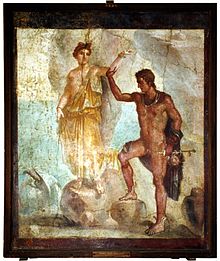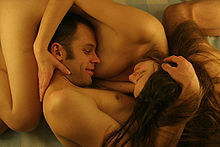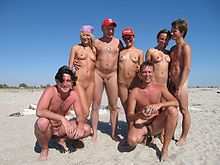- Nudity and sexuality
-
In most societies and cultures, human nudity is often associated with sexuality. Many people are sexually attracted to nudity, which they find to be erotic and sexually arousing. Some people employ their nudity to sexually attract a mate or sexual partner or as a form of flirting.
Nudity is one facet, and at times a very important facet, in the expression of feelings in intimate relationships in which there is physical or emotional intimacy. Physical intimacy is characterized by romantic or passionate love and attachment, or sexual activity.
Some people have a compulsive desire to express such emotions and to express those emotions without clothing. Some people may experience erotic and sexual pleasure in seeing their partner in the nude, or to be seen nude by the partner. Some people also experience similar pleasure from seeing other people in the nude, and being seen in the nude by others, not necessarily their immediate partner.
Some cultures equate nudity with sexuality, but that is not always the case. Historically, nudity has been practiced in some cultures without any necessary association with sexuality. Nudity can exist in non-sexual social contexts, such as naturism and figure drawing; it can be sensual though non-sexual contexts, such as erotic performance art and striptease; or in overt sexualized contexts, as in the case of pornography.
Many cultures that expect some level of modesty associate nudity with sexuality. When physical sexual attributes are shown in the mainstream media of these cultures this is often seen as being sexually related. There are cultural differences regarding the acceptability or sexualization of nudity[1], but the definition of what is lewd has also changed over the years, as has the comparative acceptability of male or female nudity.
Sexual arousal
Sexual arousal is an aspect of a person's sexuality and an indicator of sexual excitement. It is accompanied by physiological changes in the aroused person. A person cannot conceal his or her sexual arousal while fully nude; nor can they conceal the lack of arousal. Penile erection is an obvious indicator of sexual excitement of a male; while in the case of a female, the erection of her nipples is an external indicator of sexual excitement.
Nudity between sexual partners is widely accepted, and bathing with the partner, sleeping in the nude and dressing in front of partners are common. However, even in private, some partners feel uncomfortable being nude in front of another, or exposing their sexual arousal; and insist on some restrictions on their nudity. For example, a person may feel comfortable being nude only during a sexual activity, and then only with subdued lighting, or covered by a sheet or blanket.[2]
Some people have a compulsive desire to express their sexuality without clothing. Some people may experience erotic and sexual pleasure, and achieve arousal, seeing their partner or others in the nude, or to be seen nude by another person.
Naturism
In a 2009 report, Smith and King conclude that naturists have been able to sublimate their sexual impulses in a naturist environment:
- "Sexuality, when practising naturism, was found often to be suppressed through the use of rules, geographical isolation and thoughts and behaviour. Some participants found ways of exploring and enjoying their sexuality by keeping their feelings hidden and/or seeking out more sympathetic naturist environments. Naturist environments may offer a unique space in which to explore aspects of our sexuality that are currently pathologised, criminalised or commercialised."[3]
References
- ^ A modest test of cross-cultural differences in sexual modesty, embarrassment and self-disclosure. H W Smith. Journal of Qualitative Sociology. Springer, Netherlands. ISBN 0162-0436
- ^ Sexual Behavior in the Human Female: By the Staff of the Institute for Sex Research, Indiana University, Alfred C. Kinsey ... [et al.] ; with a New Introduction by John Bancroft. Indiana University Press, 1998. ISBN 025333411X
- ^ Smith and King, Health & Place, Volume 15, Issue 2 (2009), pp. 439-446.
Categories:
Wikimedia Foundation. 2010.



